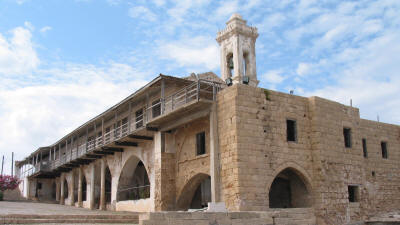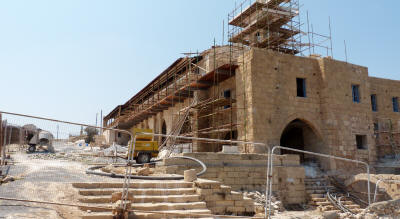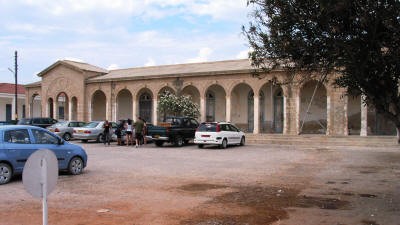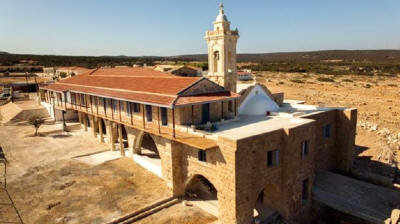Apostolos Andreas Monastery
Karpaz, North Cyprus
 |
| Apostolos Andreas Monastery |
The Apostolos Andreas Monastery is situated almost at the end of the Karpaz peninsula. (You still have about 5Km to go before Cape Zafer itself). It is named after St Andrew, who was a follower of John the Baptist, and was the first to be called by Jesus Christ to spread Christianity. It is a place of reverence by both Turkish and Greek Cypriots.
It is thought that there has been a monastery here since Byzantine times, and is possibly the location of the surrender of Isaac Commenos to Richard the Lionheart in 1191, although no trace of any structure now remains.
 |
| The Monastery during renovation |
The monastery was supposedly founded here, as during a journey to Palestine, the ship which was transporting Andrew went off course and struck the rocks here. On coming ashore, Andrew struck the rocks with his staff, at which point a spring gushed forth. The waters proved to have healing powers, and restored the sight of the ship's captain who had been blind in one eye. Thereafter, the site became a place of pilgrimage, and in the 15th century, a small chapel was built close to the shore, where to this day, you can still collect the healing water. The church of the main monastery dates to the 18th century, while the main buildings are 100 years younger.
Mass pilgrimage, however, is only comparatively recent, dating back to the early years of the 20th century. The story is told that in 1895, the son of Maria Georgiou was kidnapped. Seventeen years later, the Apostle appeared to her in a dream, telling her to pray for her son's return at the monastery. Living in Anatolia, she embarked on the crossing to Cyprus on a very crowded boat. Telling her story during the journey, one of the passengers, a young Dervish priest became more and more interested. Asking if her son had any distinguishing marks, and on hearing of a pair of birthmarks, he stripped off his cloths to reveal the same marks, and mother and son were reunited.
 |
| The Monastery Cloisters |
After 1974, most of the Greek Cypriots in the area moved to the south, although a few remained in Dipkarpaz. For 30 years, very few pilgrims visited the monastery, but with the opening of the crossing points, this flow is now increasing.
On your arrival, you will park in a courtyard, surrounded by cloisters where the pilgrims once stayed. Looking towards the sea, you will see the bell tower of the church. here you will find some icons, and normally some nuns or a retired priest acting as caretakers. Further down the slope you will reach the oldest part of the monastery and the holy well.
On two days of the year, the monastery becomes very busy; August the 15th (Assumption Day), and the 30th November, which is St Andrew's saints day. (Andrew is not only the patron saint of Scotland, but of Greece, Cyprus and Russia.)
 |
| Completed phase one |
Although the monastery had fallen into a certain state of disrepair in recent years, UN funding is in place to pay for refurbishment, along with the Hala Sultan Tekke near Larnaca.
Renovation work should have started in 2009. However disputes over who should do the work, and who should oversee the work delayed things, and a start was not made till September 2014. The work was undertaken by two construction companies, one Greek Cypriot and one Turkish Cypriot. The work was overseen by the Church of Cyprus and the Turkish Cypriot Efkaf administration.
The first phase concerned the restoration of the main church and the building of a new north arcade. On November 30th, St Andrew's day, the completed first phase was handed back to the Church of Cyprus, and a service was held.
There is still some way to go. Phase two starts in 2017 and will see the chapel and the fountain close to the shore renovated. Phase three will see the restoration of the buildings to the north of the church, and the final will involve the completion of external works below the main road, and landscaping.
See the location on Google maps.
Return to Dipkarpaz index.